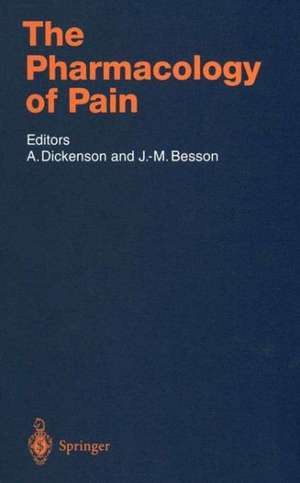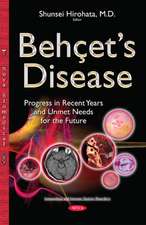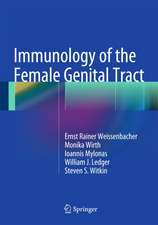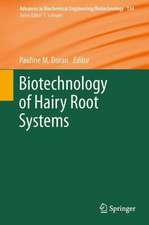The Pharmacology of Pain: Handbook of Experimental Pharmacology, cartea 130
Editat de A. Dickenson, J. -M. Bessonen Limba Engleză Paperback – oct 2011
Din seria Handbook of Experimental Pharmacology
- 5%
 Preț: 3517.78 lei
Preț: 3517.78 lei - 5%
 Preț: 1425.97 lei
Preț: 1425.97 lei - 5%
 Preț: 1435.28 lei
Preț: 1435.28 lei - 5%
 Preț: 1430.52 lei
Preț: 1430.52 lei - 5%
 Preț: 1930.69 lei
Preț: 1930.69 lei - 5%
 Preț: 1922.47 lei
Preț: 1922.47 lei - 5%
 Preț: 1937.46 lei
Preț: 1937.46 lei - 5%
 Preț: 2117.58 lei
Preț: 2117.58 lei - 5%
 Preț: 2119.96 lei
Preț: 2119.96 lei - 5%
 Preț: 2117.38 lei
Preț: 2117.38 lei - 5%
 Preț: 1088.15 lei
Preț: 1088.15 lei - 5%
 Preț: 1098.27 lei
Preț: 1098.27 lei - 5%
 Preț: 1420.29 lei
Preț: 1420.29 lei - 5%
 Preț: 1104.84 lei
Preț: 1104.84 lei - 5%
 Preț: 1104.84 lei
Preț: 1104.84 lei - 5%
 Preț: 1108.14 lei
Preț: 1108.14 lei - 5%
 Preț: 1106.69 lei
Preț: 1106.69 lei - 5%
 Preț: 1105.77 lei
Preț: 1105.77 lei - 5%
 Preț: 1174.35 lei
Preț: 1174.35 lei - 5%
 Preț: 408.48 lei
Preț: 408.48 lei - 5%
 Preț: 409.63 lei
Preț: 409.63 lei - 5%
 Preț: 539.89 lei
Preț: 539.89 lei - 5%
 Preț: 720.47 lei
Preț: 720.47 lei - 5%
 Preț: 733.09 lei
Preț: 733.09 lei - 5%
 Preț: 731.27 lei
Preț: 731.27 lei - 5%
 Preț: 746.43 lei
Preț: 746.43 lei - 5%
 Preț: 747.72 lei
Preț: 747.72 lei - 5%
 Preț: 725.24 lei
Preț: 725.24 lei - 5%
 Preț: 742.80 lei
Preț: 742.80 lei - 5%
 Preț: 393.23 lei
Preț: 393.23 lei - 5%
 Preț: 735.66 lei
Preț: 735.66 lei - 5%
 Preț: 728.33 lei
Preț: 728.33 lei - 5%
 Preț: 389.52 lei
Preț: 389.52 lei - 5%
 Preț: 730.71 lei
Preț: 730.71 lei - 5%
 Preț: 740.58 lei
Preț: 740.58 lei - 5%
 Preț: 730.19 lei
Preț: 730.19 lei - 5%
 Preț: 723.42 lei
Preț: 723.42 lei - 5%
 Preț: 731.27 lei
Preț: 731.27 lei - 5%
 Preț: 726.68 lei
Preț: 726.68 lei - 5%
 Preț: 3516.49 lei
Preț: 3516.49 lei - 5%
 Preț: 729.26 lei
Preț: 729.26 lei - 5%
 Preț: 737.11 lei
Preț: 737.11 lei - 5%
 Preț: 730.92 lei
Preț: 730.92 lei - 5%
 Preț: 738.78 lei
Preț: 738.78 lei - 5%
 Preț: 909.94 lei
Preț: 909.94 lei - 5%
 Preț: 720.10 lei
Preț: 720.10 lei - 5%
 Preț: 734.74 lei
Preț: 734.74 lei - 5%
 Preț: 727.80 lei
Preț: 727.80 lei - 5%
 Preț: 3513.38 lei
Preț: 3513.38 lei
Preț: 727.24 lei
Preț vechi: 765.51 lei
-5% Nou
Puncte Express: 1091
Preț estimativ în valută:
139.16€ • 145.01$ • 115.22£
139.16€ • 145.01$ • 115.22£
Carte tipărită la comandă
Livrare economică 03-17 aprilie
Preluare comenzi: 021 569.72.76
Specificații
ISBN-13: 9783642645501
ISBN-10: 364264550X
Pagini: 508
Ilustrații: XXII, 479 p.
Dimensiuni: 155 x 235 x 30 mm
Greutate: 0.7 kg
Ediția:Softcover reprint of the original 1st ed. 1997
Editura: Springer Berlin, Heidelberg
Colecția Springer
Seria Handbook of Experimental Pharmacology
Locul publicării:Berlin, Heidelberg, Germany
ISBN-10: 364264550X
Pagini: 508
Ilustrații: XXII, 479 p.
Dimensiuni: 155 x 235 x 30 mm
Greutate: 0.7 kg
Ediția:Softcover reprint of the original 1st ed. 1997
Editura: Springer Berlin, Heidelberg
Colecția Springer
Seria Handbook of Experimental Pharmacology
Locul publicării:Berlin, Heidelberg, Germany
Public țintă
Professional/practitionerCuprins
1 Animal Models of Analgesia.- A. Introduction.- B. Animal Models and Ethics.- C. Factors Affecting Measurements of Nociception.- D. Tests of Nociception and Analgesia.- E. Comparative Aspects.- F. Conclusion.- References.- 2 Peripheral Mediators of Pain.- A. Introduction.- B. Chemical Signalling in Fine Afferent Neurones.- C. Mediators Generated by Tissue Damage and Inflammation.- D. Mediators Released from Neurones.- E. Inflammatory Mediators from Immune Cells.- F. Exogenous Modulators of Sensory Fibre Activity: Vanilloids (Capsaicin Analogues).- G. Ion Channels Activity and Chronic Pain.- H. Summary.- References.- 3 Non-steroidal Anti-inflammatory Drugs and Pain.- A. Inflammatory Pain and NSAIDs.- B. Cyclo-oxygenase.- C. Prostaglandins and Inflammatory Pain.- D. Nitric Oxide and Nociception.- E. Conclusion.- References.- 4 The Sympathetic Nervous System and Pain.- A. Introduction.- B. The Emergence of the Concept of an Interaction Between the Sympathetic and the Somatosensory System.- C. Sympathetic Activation Has a Negligible Effect on Normal Sensory Processing.- D. Several Interactions Between the Sympathetic and the Nociceptive Systems Develop After Nerve Injury.- E. Can the Sympathetic Nervous System Modulate Pain and Hyperalgesia Under Inflammatory Conditions?.- References.- 5 Excitability Blockers: Anticonvulsants and Low Concentration Local Anesthetics in the Treatment of Chronic Pain.- A. Introduction.- B. Anticonvulsants in the Treatment of Neuropathic Pain.- C. Systemically Administered Local Anesthetics in the Treatment of Neuropathic Pain.- D. Mechanisms of Action: Anticonvulsants and Local Anesthetics Suppress Abnormal Primary Afferent Firing.- E. Summary.- References.- 6 Tachykinins: Central and Peripheral Effects.- A. Introduction.- B. Substance P andNK-1 Receptors.- C. NK-1 Receptor Antagonists.- D. Therapeutic Potential of Drugs Acting at NK-1 Receptors.- E. Summary.- References.- 7 Growth Factors and Pain.- A. Introduction.- B. NGF and Its Receptors.- C. NGF as A Mediator of Persistent Pain.- D. Mechanisms of NGF-Induced Hyperalgesia.- E. Growth Factors and Neuropathic Pain.- F. Conclusions.- References.- 8 Mechanisms of Central Hypersensitivity: Excitatory Amino Acid Mechanisms and Their Control.- A. Central Hypersensitivity.- B. Substrates for Central Hypersensitivity.- C. Mechanisms of Central Hypersensitivity.- D. NMDA Antagonists and Spinal Hypersensitivity in Persistent Pain States.- E. Controlling NMDA Receptor Activation.- F. Indirect Influences on NMDA Receptor Activation.- G. Conclusions.- References.- 9 Novel Modulators in Nociception.- A. Introduction.- B. Nitric Oxide.- C. Cholecystokinin.- D. Galanin.- References.- 10 Pharmacological Studies of Nociceptive Systems Using the C-Fos Immunohistochemical Technique: An Indicator of Noxiously Activated Spinal Neurones.- A. Introduction.- B. Spinal Expression of c-Fos: Physiological Aspects.- C. Pharmacological Aspects.- D. Conclusion.- References.- 11 Molecular Aspect of Opioid Receptors.- A. Introduction.- B. cDNA Cloning of Opioid Receptors.- C. cDNA Cloning of an Opioid-like Orphan Receptor.- D. Structural Features of the Opioid Receptor Family.- E. Opioid Receptor Genes.- F. Conclusion: Reconciling Pharmacology and Gene Cloning?.- References.- 12 Opioid Pharmacology of Acute and Chronic Pain.- A. Introduction.- B. Pharmacological Characterization.- C. Physiological Roles.- D. Pathological Roles: Opioids and Neuropathic Pain.- E. Conclusions.- References.- 13 Opioid Problems, and Morphine Metabolism and Excretion.- A. Clinical Aspects.- B. Morphine andMetabolites.- C. Conclusions.- References.- 14 Inhibitory Neurotransmitters and Nociception: Role of GABA and Glycine.- A. Introduction.- B. GABA.- C. Glycine.- D. Summary.- References.- 15 The Role of Descending Noradrenergic and Serotoninergic Pathways in the Modulation of Nociception: Focus on Receptor Multiplicity.- A. General Introduction.- B. Control of Sympathetic and Motor Function at the Segmental Level: Relevance to Pain and Its Modulation.- C. Noradrenaline, Adrenaline and Adrenergic Receptors.- D. Serotonin and Serotonin Receptors.- E. General Discussion and Conclusions.- References.- 16 Neonatal Pharmacology of Pain.- A. Introduction.- B. Neonatal Pharmacology of Excitatory Pathways Involved in Pain.- C. Neonatal Pharmacology of Inhibitory Pathways Involved in Pain.- D. Concluding Comments.- References.










